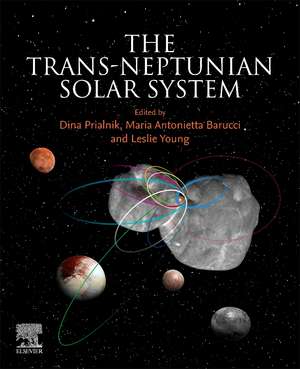The Trans-Neptunian Solar System
Editat de Dina Prialnik, Maria Antoinetta Barucci, Leslie Youngen Limba Engleză Paperback – 21 noi 2019
Offering a complete look at exploration and findings in the Kuiper Belt and the rest of the outer solar system beyond Neptune, this book is an important resource to bring planetary scientists, space scientists and astrophysicists up-to-date on the latest research and current understandings.
- Provides the most up-to-date information on the exploration of the Trans-Neptunian Solar System and what it means for the future of outer solar system research
- Contains clear sections that provide comprehensive coverage on the most important facets of the outer Solar System
- Includes four-color images and data from important missions, including New Horizons and Rosetta
- Concludes with suggestions and insights on the future of research on Trans-Neptunian objects
Preț: 671.11 lei
Preț vechi: 859.11 lei
-22% Nou
Puncte Express: 1007
Preț estimativ în valută:
128.46€ • 139.58$ • 107.97£
128.46€ • 139.58$ • 107.97£
Carte tipărită la comandă
Livrare economică 14-28 aprilie
Preluare comenzi: 021 569.72.76
Specificații
ISBN-13: 9780128164907
ISBN-10: 0128164905
Pagini: 478
Ilustrații: 150 illustrations (100 in full color)
Dimensiuni: 191 x 235 mm
Greutate: 0.81 kg
Editura: ELSEVIER SCIENCE
ISBN-10: 0128164905
Pagini: 478
Ilustrații: 150 illustrations (100 in full color)
Dimensiuni: 191 x 235 mm
Greutate: 0.81 kg
Editura: ELSEVIER SCIENCE
Public țintă
Planetary scientists, especially those interested in the outer solar system and the possibility of Planet 9, space scientists and geophysicistsSecondary Audience: Graduate students studying planetary sciences, astronomy and astrophysics, and space sciences
Cuprins
I. Physical properties of TNOs
II. Large members of the KB
III. Planet 9 and related objects
IV. Binaries and multiple systems
V. Formation and evolution
VI. Relationship with other populations
VII. Extrasolar KBO populations Epilogue – Prospects for KBO Research
II. Large members of the KB
III. Planet 9 and related objects
IV. Binaries and multiple systems
V. Formation and evolution
VI. Relationship with other populations
VII. Extrasolar KBO populations Epilogue – Prospects for KBO Research
